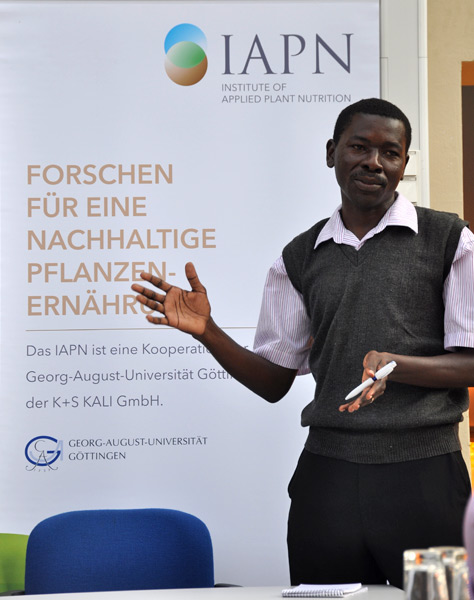The Institute of Applied Plant Nutrition (IAPN) hosted a discussion afternoon attended by students, scientists and other guests, looking at the importance of education for ensuring that the nutritional and economic needs of smallholders in Uganda are met.
IAPN press release 25 September 2013
The highlight of the event was a discussion with Daniel Olol from Uganda. Mr. Olol is a young agricultural scientist from an NGO called Sasakawa Africa Association (SAA).
Daniel Olol of the NGO Sasakawa Africa Association explains the situation of smallholder farming in Uganda. (Photo: Dach)
He is a guest of the IAPN within the framework of “Growth for Uganda”, here to benefit from the Institute’s knowledge of applied plant nutrition and specialized methods of soil and plant analysis. His mission is to pass his knowledge on both to educators and directly to smallholders in his home country, and to work with them to develop appropriate methods of fertilization for crop plants. “The yields our farmers are getting are considerably less than what they could be. There is a lack of specialist knowledge”, said Mr. Olol. SAA works to help the farmers to increase yields using good agricultural practice. “We teach groups of smallholders by involving them in what we call our Training Platforms. These incorporate demonstration experiments, teaching units, skilled mentoring and specialist support for the farming sector.
Using a truck-based mobile classroom, in the coming years up to 50,000 smallholders are expected to receive help in increasing their harvests and thereby ensure that their families have enough to eat and enjoy a more secure financial situation. The mobile classroom includes a laboratory to enable the analysis of the nutrient content of soils and plants – the results provide an important foundation for the SAA’s tailor-made fertilizer advice.
Cooperation for more knowledge transfer: Prof. Dr. Klaus Dittert, IAPN; Daniel Olol, Sasakawa Africa Association; Prof. Dr. Andreas Gransee, K+S KALI GmbH (L .t.r.). (Photo: Dach)
Alongside the research into current questions relating to applied plant nutrition, the IAPN has taken on responsibility for knowledge transfer, all the way to the people who have responsibility for applying fertilizer. “Comparatively small changes to methods of cultivation in countries with smallholder structures can lead to relatively large yield increases, because the existing yield levels are often significantly below the optimum”, said Prof. Dr. Klaus Dittert, chief scientist at the IAPN. “Daniel Olol knows Uganda’s farming sector very well, and we are very pleased to be able to support him – both with our specialist knowledge and with practical training in soil and plant analysis. He has been a very enthusiastic learner and will no doubt teach with the same energy back home. In this way Mr. Olol will be a great support making available knowledge to be put to use in Uganda.“
In a personal conversation: Daniel Olol, Sasakawa Africa Association, and participants of the event “IAPN in Dialogue”. (Foto: Dach)
IAPN’s work with the Sasakawa Africa Association has been made possible by K+S KALI GmbH through the “Growth for Uganda” project that they launched with SAA in May 2013. The fertilizer producer is one of the sponsors of the IAPN and is internationally active in research and advice regarding customized plant nutrition. At the IAPN event, Prof. Dr. Andreas Gransee, Head of Applied Research and Advisory Service Agro at K+S KALI introduced the “Growth for Uganda” project and said: “There’s also much we can learn about the situation for smallholders in Uganda, and with that increased awareness we can direct our products at Africa’s needs more effectively. Thus we see a transfer of knowledge with long-term benefits for both sides.”
The “IAPN in Dialogue” gave students, scientists and other guests a chance to gain an understanding of smallholder agriculture and have their questions answered by someone with firsthand experience. The main focus was on the importance of scientific knowledge regarding maintenance of soil fertility and appropriate cultivation methods, for an increase in productivity of smallholders in Africa.
Download of photos in print quality
 Download
Download
 Download
Download
 Download
Download
 Download
Download







